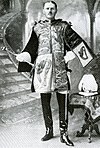Portal:Heraldry
Welcome to the Heraldry and Vexillology Portal!


Vexillology (from the Latin vexillum, a flag or banner) is the scholarly study of flags, including the creation and development of a body of knowledge about flags of all types, their forms and functions, and of scientific theories and principles based on that knowledge. Flags were originally used to assist military coordination on the battlefield, and have evolved into a general tool for signalling and identification, particularly identification of countries.
Heraldry encompasses all of the duties of a herald, including the science and art of designing, displaying, describing and recording coats of arms and badges, as well as the formal ceremonies and laws that regulate the use and inheritance of arms. The origins of heraldry lie in the medieval need to distinguish participants in battles or jousts, whose faces were hidden by steel helmets.
Selected article

Canadian heraldry refers to the cultural tradition and style of coats of arms and other heraldic achievements in modern and historic Canada, including national, provincial, and civic arms, noble and personal arms, ecclesiastical heraldry, heraldic displays as corporate logos, and Canadian heraldic descriptions.
Canadian heraldry derives mainly from heraldic traditions in France and the United Kingdom while adding distinctly Canadian symbols, especially those which reference the First Nations and other aboriginal peoples of Canada. Canadian heraldry has a unique system of cadency for daughters inheriting arms, and a special symbol for United Empire Loyalists. Since 1988, both personal and corporate heraldry in Canada is officially governed by the Canadian Heraldic Authority, which reviews all applications for arms. (more...)
Selected flag

The flag of the Republic of China, commonly known as Taiwan, was first used in mainland China by the Kuomintang (KMT, Chinese Nationalist Party) in 1917 and was made the official flag of the ROC in 1928. It was enshrined in the 6th article of the Constitution of the Republic of China when it was promulgated in 1947. Since 1949, the flag is mostly used within Taiwan where the Republic of China relocated after having lost the Chinese Civil War to the People's Republic of China.
In Chinese, the flag is commonly described as Blue Sky, White Sun, and a Wholly Red Earth (traditional Chinese: 青天, 白日, 滿地紅; simplified Chinese: 青天, 白日, 满地红; pinyin: Qīng Tiān, Bái Rì, Mǎn Dì Hóng) to reflect its attributes. The canton (upper corner on the hoist side) originated from the "Blue Sky with a White Sun flag" proposed by Lu Hao-tung in 1895 and adopted as the KMT party flag. The "red earth" portion was added by Sun Yat-sen in 1906. After the Republican revolution, the provisional Senate selected the "Five-Colored Flag" as the national flag in 1912. After President Yuan Shikai suppressed the KMT, Sun Yat-sen established a government-in-exile in Tokyo and eventually a rival government in Guangzhou in 1917, using the KMT flag as the national ROC flag. This flag was made the official national flag on December 17, 1928 after the Northern Expedition toppled the Beiyang government. (more...)
Selected biography

John Anstis (29 August 1669–4 March 1744) was an English officer of arms and antiquarian. He rose to the highest heraldic office in England and became Garter King of Arms in 1718 after years of plotting. Anstis was born at St Neot, Cornwall on 29 August 1669. He was the first son of another John Anstis and his wife Mary, the daughter of George Smith. Anstis matriculated at Exeter College, Oxford, on 27 March 1685 and entered the Middle Temple on 31 January 1690. On 23 June 1695 he married Elizabeth, daughter and heir of Richard Cudlipp of Tavistock, Devon. They had eight sons and six daughters. (more...)
Selected picture

A medieval ship flag captured by forces from Lübeck in the 1420s showed the arms of Denmark, Sweden, Norway and Pomerania. It remained in this city for 500 years, until destroyed in a World War II bombardment that damaged St. Mary's Church where the flag was kept. A 19th century copy remains in Frederiksborg Palace, Denmark. The saint accompanying the Virgin Mary and infant Christ is Saint James the Greater, identified by his scallop shell emblem. The flag was made of coarse linen; all figures and heraldic insignia were created using oil-based paint.
Did you know...
- ...that the British First World War general Sir William Peyton (pictured) served as Delhi Herald Extraordinary at the Delhi Durbar of 1911?
- ...that the sculptor Gilbert Ledward created a new Great Seal of the Realm in 1953?
- ...that it has been claimed that Clan Schaw descends from cup bearers to the Scots kings Alexander II or Alexander III; and that the clan's coat of arms alludes to the office of cup bearer?
- ...that the Pennon, one of the principal varieties of flag carried during the Middle Ages, derives its name from the Latin penna, meaning wing?
- ...that Paul Bunker died in a Japanese POW camp in 1943 but kept hidden a remnant of the U.S. flag from the Battle of Corregidor now displayed at the West Point Museum?
Related portals
|
|
|
Heraldry Web resources
Authorities
- Belgium - The Council of Nobility, Flemish Heraldic Council and Council of Heraldry and Vexillology of the French Community
- Canada - Canadian Heraldic Authority and see also Public Register of Arms, Flags and Badges
- England, Wales, and Northern Ireland - The College of Arms
- Ireland - The Office of the Chief Herald of Ireland
- Netherlands - High Council of Nobility
- Portugal - Instituto da Nobreza Portuguesa
- Scotland - The Court of the Lord Lyon
- South Africa - South African Bureau of Heraldry
- Sweden - National Board of Heraldry, The National Archive
- United States Army - The United States Army Institute of Heraldry
Societies
- Greek Heraldry Society
- The Academy of Heraldic Science Czech republic
- The American College of Heraldry
- The American Heraldry Society
- The Augustan Society
- The Australian Heraldry Society Inc.
- Bulgarian Heraldry and Vexillology Society
- The Center for Research of Orthodox Monarchism
- Cambridge University Heraldic and Genealogical Society
- Chiltern Heraldry Group
- The College of Dracology
- Croatian Heraldic and Vexillologic Association
- The Finnish Heraldic Society
- Fryske Rie foar Heraldyk
- Hellenic Armigers Society
- Guild of Heraldic Artists
- Genealogical Society of Ireland
- Heraldry Research Institute (Japan)
- The Heraldry Society
- The Heraldry Society of Africa
- The Heraldry Society of New Zealand Inc.
- The Heraldry Society of Scotland
- The Heraldry Society of Southern Africa
- The Institute of Heraldic and Genealogical Studies
- The International Association of Amateur Heralds
- Italian Center of Vexillological Studies
- Lancashire Heraldry Group
- Macedonian Heraldry Society
- New England Historic Genealogical Society Committee on Heraldry
- Norwegian Heraldry Society
- Oxford University Heraldry Society
- Polish Heraldry Society
- Polish Nobility Confederation
- Real Academia Matritense de Heráldica y Genealogía - Royal Academy of Heraldry and Genealogy of Madrid
- Romanian Institute for Genealogy and Heraldry
- The Royal Heraldry Society of Canada
- The Russian College of HeraldryThe Russian College of Heraldry
- Serbian Heraldic Society
- Societas Heraldica Scandinavica
- Societas Heraldica Slovenica
- Swedish Heraldic Society
- Ukrainian Heraldry Society
- Royal Association Genealogical and Heraldic Office of Belgium
Vexillology
Software
- Coat of Arms Visual Designer web-based program
- Puncher Heraldry Program
- Blazonry Server - pyBlazon
- DrawShield - creates SVG shield or arms image from blazon
- CoaMaker - web-based tool
- Blazon95 and BLAZONS! 2000, older Windows applications
Texts
- Heraldry, historical and popular : with seven hundred illustrations (1863)
- A Complete Guide to Heraldry (1909)
Other
Wikimedia
The following Wikimedia Foundation sister projects provide more on this subject:
-
Commons
Free media repository -
Wikibooks
Free textbooks and manuals -
Wikidata
Free knowledge base -
Wikinews
Free-content news -
Wikiquote
Collection of quotations -
Wikisource
Free-content library -
Wikispecies
Directory of species -
Wikiversity
Free learning tools -
Wikivoyage
Free travel guide -
Wiktionary
Dictionary and thesaurus
- Portals with triaged subpages from February 2020
- All portals with triaged subpages
- All portals
- Portals with no named maintainer
- Random portal component with more available subpages than specified max
- Random portal component with 16–20 available subpages
- Random portal component with 31–40 available subpages
- Random portal component with 26–30 available image subpages
- Heraldry
- History portals
- Society portals
- Heraldry portal
- WikiProject Heraldry and vexillology











